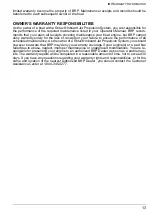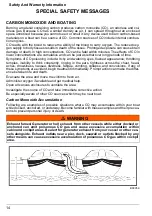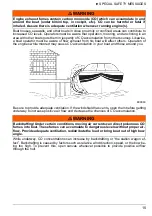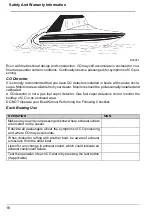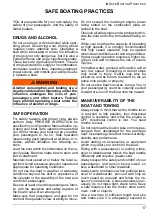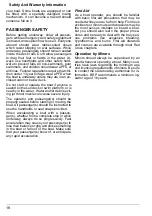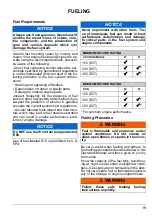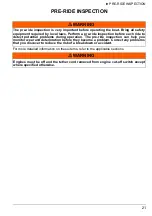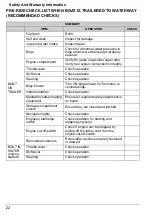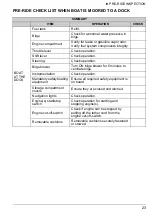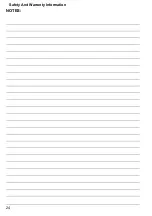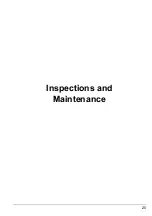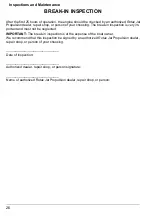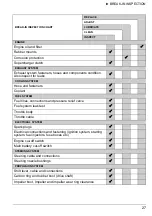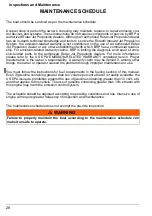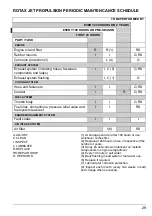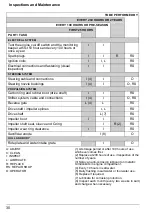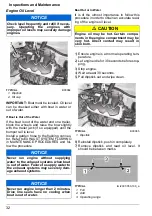
17
S
AFE
B
OATING
P
RACTICES
SAFE BOATING PRACTICES
YOU are responsible for your own safety, the
safety of your passengers, and the safety of
fellow boaters.
DRUGS AND ALCOHOL
Do not use drugs or drink alcohol while oper-
ating a boat. Like driving a car, driving a boat
requires sober, attentive care. Operating a
boat while intoxicated or under the influence
of drugs is not only dangerous, but it is also a
Federal offense carrying a significant penalty.
These laws are vigorously enforced. The use
of drugs and alcohol, singly or in combination,
decreases reaction time, impedes judgment,
impairs vision, and inhibits your ability to safe-
ly operate a boat.
SAFE OPERATION
For safety reasons and proper care, always
perform daily PRE-RIDE INSPECTION as
specified in your Operators Manual before op-
erating your boat. Safe operation means that
you do not misuse your boat nor do you allow
your passengers to do so. Safe operation
means using good judgment at all times. It in-
cludes, without limitation, the following ac-
tions:
Load the boat within the limits listed on the ca-
pacity plate. Balance loads bow to stern and
port to starboard.
Maintain boat speed at or below the local le-
gal limit. Avoid excessive speed or speeds not
appropriate for operating conditions.
Do not use the boat in weather or waterway
conditions beyond the skill or experience of
the operator or the capability of the boat and
comfort of passengers.
Be sure at least one other passenger is famil-
iar with the operation and safety aspects of
the boat in case of an emergency.
Make sure that passengers and gear do not
obstruct the operator's view or ability to move.
Do not exceed the maximum engine power
rating stated on the certification plate at-
tached to the boat.
Observe all safety signs and warnings both in-
side the boat and in the immediate boating ar-
ea.
While your boat has the capacity of operating
at high speeds, it is strongly recommended
that high speed operation only be applied
when ideal conditions exist and are permitted.
Higher speed operation requires a higher de-
gree of skill and increases the risk of severe
injuries.
In shallow water, proceed with caution and at
very low speed. Grounding or abrupt stops
may result in injury. Debris may also be
picked up and be thrown rearward by the jet
pump onto people or property.
Do not use the boat's reverse, to stop. You or
your passenger(s) could be violently ejected
forward or even off the boat onto the hazard.
MANEUVERABILITY OF THE
BOAT AND TOWING
Always keep in mind that as the throttle lever
is returned to idle position, less directional
control is available, and when the engine is
OFF, directional control is lost. You need
throttle to steer.
Do not overload the boat or take on more pas-
sengers than designated for the particular
boat. Overloading can affect maneuverability,
stability and performance.
Avoid adding on accessories or equipment
which may alter your control of the boat.
Riding with a passenger(s) or pulling a tube,
skier or wakeboarder makes the boat handle
differently and requires greater skill.
Always respect the safety and comfort of your
passenger(s) and person being towed on
skis, wakeboard or other towables.
Always carry an observer when pulling a tube,
skier or wakeboarder, proceed with only as
much speed as required and follow the ob-
server's instructions. Unless absolutely nec-
essary, do not make tight, sharp turns. Keep
a safe distance from the docks, other swim-
mers, craft or objects.
Use a tow rope of sufficient length and size
and make sure it is adequately secured to
WARNING
Alcohol consumption and boating are a
deadly combination! Operating under the
influence endangers the lives of your
passengers and other boaters. Federal
laws prohibit operating a boat under the
influence of alcohol or drugs.
Summary of Contents for Rotax 4-TEC 150
Page 5: ...Safety And Warranty Information ...
Page 28: ...24 Safety And Warranty Information NOTES ...
Page 29: ...25 Inspections and Maintenance ...
Page 45: ...41 Technical Information and Specifications ...
Page 50: ...46 Technical Information and Specifications NOTES ...
Page 51: ...47 Troubleshooting Guidelines ...
Page 59: ...55 Break In and Special Procedures ...
Page 63: ......











